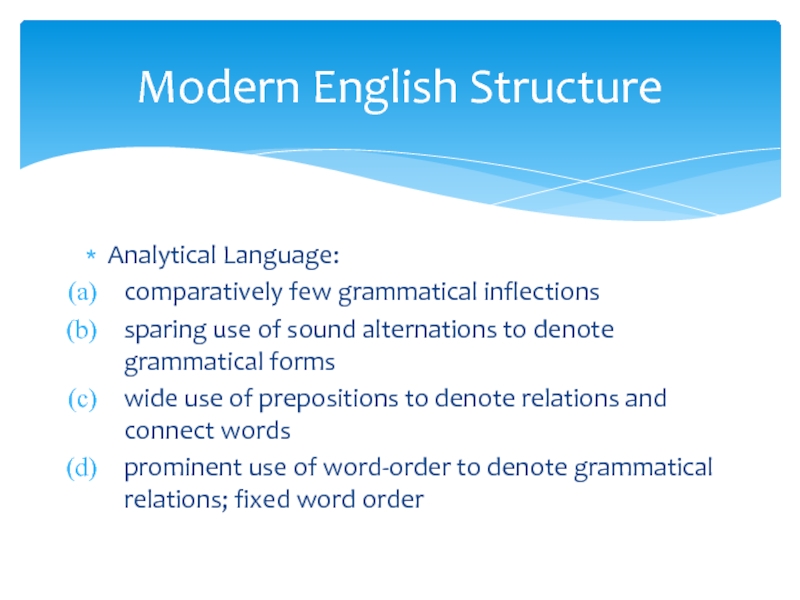Units
of language are divided into segmental
and
supra-segmental.
Segmental
units consist of phonemes, they form phonemic strings of various
status (syllables, morphemes, words, etc.). Supra-segmental units do
not exist by themselves, but are realized together with segmental
units and express different modificational meanings (functions) which
are reflected on the strings of segmental units. To the
supra-segmental units belong intonations (intonation contours),
accents, pauses, patterns of word order.
The
segmental units of language form a hierarchy of levels. This
hierarchy is of a kind that units of any higher level are
analysable into (i.e. are formed of) units of the immediately lower
level. Thus, morphemes are decomposed into phonemes, words are
decomposed into morphemes, phrases are decomposed into words, etc.

this hierarchical relation is by no means reduced to the mechanical
composition of larger units from smaller ones; units of each level
are characterized by their own, specific functional features which
provide for the very recognition of the corresponding levels of
language.
The
lowest level of lingual segments is phonemic:
it
is formed by phonemes as the material elements of the
higher-level segments. The phoneme has no meaning, its function
is purely differential: it differentiates morphemes and words as
material bodies. Since the phoneme has no meaning, it is not a sign.
Phonemes
are combined into syllables. The syllable, a rhythmic segmental
group of phonemes, is not a sign, either; it has a purely formal
significance. Due to this fact, it could hardly stand to reason to
recognize in language a separate syllabic level; rather, the
syllables should be considered in the light of the intra-level
combinability properties of phonemes.
Phonemes
are represented by letters in writing. Since the letter has a
representative status, it is a sign, though different in principle
from the level-forming signs of language.
Units
of all the higher levels of language are meaningful; they may be
called «signemes» as opposed to «cortemes» (from
Lat.
cortex «bark,
crust, shell»), i.e. non-meaningful units of different status,
such as phonemes (and letters as phoneme representatives), syllables,
and some others.
The
level located above the phonemic one is the morphemic
level.
The morpheme is the elementary meaningful part of the word. It is
built up by phonemes, so that the shortest morphemes include only one
phoneme. E.g.:
ros-y [-1];
a-fire
[a-];
comes
[-z].
The
morpheme expresses abstract, «significative» meanings which
are used as constituents for the formation of more concrete,
«nominative» meanings of words.
The
third level in the segmental lingual hierarchy is the level of words,
or lexemic
level.
The
word (lexeme), as different from the morpheme, is a directly naming
(nominative) unit of language: it names things and their relations.
Since words are built up by morphemes, the shortest words consist of
one explicit morpheme only. Cf.:
man, will, but, I, etc.
The
next higher unit is the phrase (word-group), it is located at the
phrasemic
level.
To level-forming phrase types belong combinations of two or more
notional words. These combinations, like separate words,
have
a nominative function, but they represent the referent of nomination
as a complicated phenomenon, be it a concrete thing, an action, a
quality, or a whole situation. Cf,
respectively:
a picturesque village; to start with a jerk; extremely difficult; the
unexpected arrival of the chief. This kind of nomination can be
called «polynomination», as different from
«mononomination» effected by separate words.
Notional
phrases may be of a stable type and of a free type. The stable
phrases (phraseological units) form the phraseological part of the
lexicon, and are studied by the phraseological division of
lexicology. Free phrases are built up in the process of speech on the
existing productive models, and are studied in the lower division of
syntax. The grammatical description of phrases is sometimes called
«minor syntax», in distinction to «major syntax»
studying the sentence and its textual connections.
In
order to better understand the nature of phrases as level-forming
units we must take into consideration their status in the larger
lingual units built up by them. These larger units are sentences. It
is within the sentence that any phrase performs its level-determined
function (being used as a notional part of the sentence). On the
other hand, any notional word, not only a phrase, can be used in the
role of a separate part of the sentence, such as subject, object,
predicate, etc. We infer from this that in more exact terms the units
located above the words in the segmental lingual hierarchy are
notional parts of the sentence. These can be formed by phrases
(word-groups), or by separate notional words. Since the function
of these parts is denotative
(they
not only name, but also indicate, or denote,
objects
and phenomena involved in the situation expressed by the sentence),
they may be called «denotemes»
(in
the previous editions of the book they were referred to as
«nomemes»). The level at which denotemes are identified is
then the denotemic
level
of language. In this connection, the phrasemic level should be
presented as the upper sublev-el of the denotemic level. The
demonstrated approach marks the necessary development of the
theory of levels of language emphasizing the strictly hierarchical
principle of inter-level derivational relations of lingual units
(see above).
Above
the denotemic level, the level of sentences is located, or the
proposemic
level.
The
peculiar character of the sentence («proposeme») as a
signemic unit of language consists in the fact that, naming a certain
situation, or situational event, it expresses predication, i.e. shows
the relation of the denoted event to reality. Namely, it shows
whether this event is real or unreal, desirable or obligatory, stated
as a truth or asked about, etc. In this sense, as different from the
word and the phrase, the sentence is a predicative unit. Cf.
to receive — to receive a letter —
Early
in June I received a letter from Peter Melrose.
The
sentence is produced by the speaker in the process of speech as a
concrete, situationally bound utterance. At the same time it enters
the system of language by its syntactic pattern, which, as all the
other lingual unit-types, has both syntagmatic and paradigmatic
characteristics.
But
the sentence is not the highest unit of language in the hierarchy of
levels. Above the proposemic level there is still another one whose
units are formed by separate sentences united into topical groupings.
These sentence-groups, each distinguished by its micro-topic as part
of a continual text, are tentatively called «super-sentential
constructions». For the sake of unified terminology, the level
at which they are identified can be called «supra-proposemic».
In
the printed text, the supra-sentential construction very often
coincides with the paragraph (as in the example above).
The
supra-sentential construction is a combination of separate sentences
forming a textual unity. Such combinations are subject to regular
lingual patterning making them into syntactic elements. The syntactic
process by which sentences are connected into textual unities is
analysed under the heading of «cumulation». Cumulation, the
same as formation of composite sentences, can be both syndetic and
asyndetic. Cf:
He
went on with his interrupted breakfast. Lisette did not speak and
there was silence between them. But
his
appetite satisfied, his mood changed; he began to feel sorry for
himself rather than angry with her, and with a strange ignorance of
woman’s heart he thought to arouse Lisette’s remorse by exhibiting
himself as an object of pity (S. Maugham).
In
the printed text, the supra-sentential construction very often
coincides with the paragraph (as in the example above). However,
the constitutive unit of the level in question, obeying the
universal derivational regularity of segmental lingual hierarchy,
should be reducible to one sentence only, the same as the
sentence is reducible to one denoteme (sentence-part) and the
denoteme is reducible to one lexeme (word), etc. This regularity
considered, we come to the conclusion that the generalized unit that
is located above the sentence and is distinguished by its topical
(micro-topical) function is not necessarily represented by a group of
sentences, i.e. by a super-sentential construction; in general
terms, this unit is formed either by a group of sentences (a
super-sentential construction shown above), or by one separate
sentence which is placed in a semanti-cally (topically) significant
position in speech. In oral speech it is delimited by a long
pause combined with the corresponding «concluding» tone of
voice. We have called this generalized unit the «dicteme»
(from Lat.
dico «I
speak») [Блох,
1986,48]. In written (printed) text it is often represented by a
sentence-paragraph, i.e. by a paragraph formed by a single
independent
sentence.
Thus,
from the point of view of its constitutive units, the
supra-sentential level may be called the dictemic
level, the
dicteme
being
defined as an elementary topical segmental unit of the continual
text.
We
have surveyed six levels of language, each identified by its own
functional type of segmental units. If now we carefully observe the
functional status of the level-forming segments, we can
distinguish between them more self-sufficient and less
self-sufficient types, the latter being defined only in relation to
the functions of other level units. Indeed, the phonemic, lexemic and
proposemic levels are most strictly and exhaustively identified
from the functional point of view: the function of the phoneme is
differential, the function of the word is nominative, the function
of the sentence is predicative. As different from these, morphemes
are identified only as significative components of words, denotemes
present notional parts of sentences, and dictemes mark the transition
from the sentence to the text.
Furthermore,
bearing in mind that the phonemic level forms the sub-foundation of
language, i.e. the non-meaningful matter of meaningful expressive
means, the two notions of grammatical description shall be pointed
out as central even within the framework of the structural hierarchy
of language: these are, first, the notion of the word and, second,
the notion of the sentence. The first is analysed by morphology,
which is the grammatical teaching of the word; the second is analysed
by syntax, which is the grammatical teaching of the sentence.
ЛИТЕРАТУРА:
-
Блох,
М.Я. Теоретическая грамматика английского
языка : Учеб. / М.Я. Блох. – 5–е изд.,
стер. – М. : Высш. шк., 2006. – 423 с. -
Блох,
М.Я. Теоретические основы грамматики :
учеб. / М.Я. Блох. – 3–е изд., испр. –
М. : Высш. шк., 2002. – 160 с. -
Blokh,
M.Y. A course in theoretical English grammar / M.Y. Blokh. –
M., 1983.
Соседние файлы в предмете [НЕСОРТИРОВАННОЕ]
- #
- #
- #
- #
- #
- #
- #
- #
- #
- #
- #
3 pages, 1035 words
1. The subject of Theoretical Grammar. Different approaches to the analysis of l-ge phenomena. L. Incorporates the 3 constituent parts.
These parts are the phonological system, the lexical system, the grammatical system. Only the unity of these 3 elements forms a l-ge. The phonological syst. determines the material (phone tical) appearance of its significative units.
The lexical syst. is the whole set of naming means of l-ge, that is, w-ds and word-groups. The gr. syst. is the whole set of regularities determining the combination of naming means in the formation of utterances. Traditionally, grammar is determined as the syst.
of rules of changing of the word and the rules and regulations of their combining in the sent. That is why it is divided into 2 parts: morphology (rules of word’s changing) and syntax (rules of word combining into sentences).
The aim of theor. Gr. of the lang.
is to present a theor. description of its gr. system, i. e.
to scientifically analyze and define its gr. categories and study mechanisms of gr. formation of utterances out of words in the process of speech making. The nature of grammar as a constituent part of language is better understood in the light of explicitly discriminating the 2 planes of l-ge, namely, the plane of content and the plane of expression. The plane of content comprises the purely semantic elements contained in l-ge, while the plane of expression comprises the material (formal) units of l-ge taken by themselves, apart from meanings rendered by them.
3 pages, 1005 words
The Business plan on Public Education Is A Large And Diverse System In The
Public education is a large and diverse system in the United States of America. An important division of this system EMS is responsible for development and implementation of various safety programs with the aim of saving many lives and minimizing the chances of medical and trauma emergencies. To plan an effective public education system for an area, the knowledge of the geography plays a critical …
The 2 planes are inseparably connected, so that no meaning can be realized without some material means of expression. Gram. elements of l-ge present a unity of content and expression (a unity of form and meaning).
In this the gr.
elements are similar to the lingual lexical elements, though the quality of gr. meanings, as we have stated above, is different in principle from the quality of lexical meanings. On the other hand, the correspondence between the planes of content an expression is very complex, and it is peculiar to each language. This complexity is clearly illustrated by the phenomena of polysemy, homonymy and synonymy.
Lingual units stand to one another in 2 fundamental types of relations: syntagmatic and paradigmatic. Syntagmatic relations are immediate linear relations between units in a segmental sequence. E. g. : The spaceship was launched without the help of a booster rocket. In this sentence syntagmatically connected are the words and word-groups the spaceship, was launched, the spaceship was launched, was launched without the help, the help of a rocket, a booster rocket.
Paradigmatic relations coexist with syntagmatic relations in such a way that some sort of syntagmatic connection is necessary for the realization of any paradigmatic series. This is especially evident in a classical grammatical paradigm which presents a productive series of forms each consisting of a syntagmatic connection of two elements: one common for the whole of the series, the other specific for every individual form in the series. Grammatical paradigms express various grammatical categories. The minimal paradigm consists of 2 form-stages.
This kind of paradigm we see, for instance, in the expression of the category of number: boy – boys. A more complex paradigm can be divided into component paradigmatic series, i. e. into the corresponding sub-paradigms.
In other words, with paradigms, the same as with any other systemically organized material, macro- and micro-series are to be discriminated. Units of language are divided into segmental and supra-segmental. Segmental units consist of phonemes, they form phonemic strings of various status (syllables, morphemes).
Supra-segmental units do not exist by themselves, but are realized together with segmental units and express different modificational meanings (functions) which are reflected on the strings of segmental units. To the supra-segmental units belong intonations (intonation contours), accents, pauses, patterns of word order. The segmental units of l-ge form a hierarchy of levels.
14 pages, 6824 words
The Dissertation on Unit 7: Words and Phrases Used in Advertising
I. Introduction With increasing communication in the world and acceleration of economic globalization, English advertising has found its way into people’s life. Every day, people are exposed to a large number of advertisements no matter whether they like them or not. But what is advertising? What are the objectives of advertising? What are the functions of advertising? And what significance does a …
This hierarchy is of a kind that units of any higher level are formed of units of the immediately lower level. Thus, morphemes are decomposed into phonemes, words are decomposed into morphemes, phrases are decomposed into words, etc. The lowest level of lingual segments is phonemic, it is formed by phonemes as the material elements of the higher-level segments. The phoneme has no meaning, its function is purely differential: it differentiates morphemes and words as material bodies.
Since the phoneme has no meaning, it is not a sign. Units of all the higher levels of language are meaningful; they may be called “signe mes” as opposed to “corteses”, i. e. non-meaningful units of different status, such as phonemes, syllables, and some others. The third level in the segmental lingual hierarchy is the level of words, or lexemic level. The word (lexeme), as different from the morpheme, is a directly naming (nominative) unit of l-ge: it names things and their relations.
Since words are built up by morphemes, the shortest words consist of one explicit morpheme only. The next higher unit is the phrase, it is located at the phrase mic level. To level-forming phrase types belong combinations of 2 or more notional words. These combinations, like separate words, have a nominative function, but they represent the referent of nomination as a complicated phenomenon, be it a concrete thing, an action, a quality, or a whole situation. Then the level of sentences is located, or the proposemic level. The peculiar character of the sentence as a signe mic unit of language consists in the fact that, naming a certain situation, or situational event, it expresses predication, i.
e. shows the relation of the denoted event to reality. Namely, it shows whether this event is real or unreal, desirable or obligatory, stated as a truth or asked about, etc. In this sense, as different from the word and the phrase, the sentence is a predicative unit. The supra-proposemic construction is a combination of separate sentences forming a textual unity. In the typed text, the supra- sentential construction commonly coincides with the paragraph.
4 pages, 1918 words
The Term Paper on Higher Level Words Processing Subject
1 Abstract The experiment conducted regarding Memory Processes tested individuals on their ability to store and retrieve words. The levels on which words were stored were structural, the lowest level, phonetic, the next highest level, and semantic, the highest level of processing. The experiment is based on the recall and reorganization of the words from group they show during the experiment. The …
The next level is the level of text which consists of a group of supra- sentential constructions. The highest level is the level of discourse. Discourse is interpret as a difficult communicative phenomenon which includes in itself social context, the information about participants, knowledge about the process production and perception of the text.
All Papers Are For Research And Reference Purposes Only. You must cite our web site as your source.
- Текст
- Веб-страница
Units of language are divided into segmental and suprasegmental. Segmental units consist of phonemes, they form phonemic strings of various status (syllables, morphemes, words, etc.). Supra-segmental units do not exist by themselves, but are realised together with segmental units and express different modificational meanings (functions) which are reflected on the strings of segmental units. To the supra-segmental units belong intonations (intonation contours), accents, pauses, pat-terns of word-order.
The segmental units of language form a hierarchy of levels. This hierarchy is of a kind that units of any higher level are analyzable into (i.e. are formed of) units of the immediately lower level. Thus, morphemes are decomposed into phonemes, words are decomposed into morphemes, phrases are decomposed into words, etc.
But this hierarchical relation is by no means reduced to the mechanical composition of larger units from smaller ones; units of each level are characterised by their own, specific functional features which provide for the very recognition of the corresponding levels of language.
The lowest level of lingual segments is phonemic: it is formed by phonemes as the material elements of the higher -level segments. The phoneme has no meaning, its function is purely differential: it differentiates morphemes and words as material bodies. Since the phoneme has no meaning, it is not a sign.
Phonemes are combined into syllables. The syllable, a rhythmic segmental group of phonemes, is not a sign, either; it has a purely formal significance. Due to this fact, it could hardly stand to reason to recognise in language a separate syllabic level; rather, the syllables should be considered in the light of the intra-level combinability properties of phonemes.
0/5000
Результаты (русский) 1: [копия]
Скопировано!
Units of language are divided into segmental and suprasegmental. Segmental units consist of phonemes, they form phonemic strings of various status (syllables, morphemes, words, etc.). Supra-segmental units do not exist by themselves, but are realised together with segmental units and express different modificational meanings (functions) which are reflected on the strings of segmental units. To the supra-segmental units belong intonations (intonation contours), accents, pauses, pat-terns of word-order.The segmental units of language form a hierarchy of levels. This hierarchy is of a kind that units of any higher level are analyzable into (i.e. are formed of) units of the immediately lower level. Thus, morphemes are decomposed into phonemes, words are decomposed into morphemes, phrases are decomposed into words, etc.But this hierarchical relation is by no means reduced to the mechanical composition of larger units from smaller ones; units of each level are characterised by their own, specific functional features which provide for the very recognition of the corresponding levels of language.The lowest level of lingual segments is phonemic: it is formed by phonemes as the material elements of the higher -level segments. The phoneme has no meaning, its function is purely differential: it differentiates morphemes and words as material bodies. Since the phoneme has no meaning, it is not a sign.Phonemes are combined into syllables. The syllable, a rhythmic segmental group of phonemes, is not a sign, either; it has a purely formal significance. Due to this fact, it could hardly stand to reason to recognise in language a separate syllabic level; rather, the syllables should be considered in the light of the intra-level combinability properties of phonemes.
переводится, пожалуйста, подождите..
Результаты (русский) 3:[копия]
Скопировано!
единицы языка делятся на сегментам и suprasegmental.сегментам, группа состоит из фонемы, они образуют фонетическая строки различных статуса (слоги, morphemes, слова и т.д.).выше по сегментам подразделения существуют не сами по себе, но реализуются совместно с подразделениями по сегментам и выразить различные modificational значения (функции), в котором отражены на струнах сегментарных единиц.к выше по сегментам подразделения входят интонации (интонация контуры), акценты, паузы, пэт сроки порядок слов.совет по сегментам единиц языка форма иерархии уровнях.это происходит из того рода, что единиц выше уровня поддающихся анализу в (например, формируются) части сразу же низкого уровня.таким образом, morphemes не разлагается в фонемы, слов разлагается в morphemes, фразы, перевести в слова, и т.д.но это иерархические отношения отнюдь не до механического состава крупных подразделений из маленьких; единиц каждого уровня характеризуются свои собственные конкретные функциональных возможностей, которые предусматривают весьма признание соответствующих уровней языка.самый низкий уровень языковых сегментов — фонетическая: оно формируется фонемы, как материальные элементы высшего уровня сегментов.о… нет смысла, его задачей является чисто дифференцированный: это отличает morphemes и слова как материальных тел.поскольку… нет смысла, это не знак.фонемы, объединены в слоги.слог, ритмичный сегментам, группа фонемы, — это не знак, либо; она имеет чисто формальный характер.таким образом, вряд ли обоснованны признавать в языке отдельной формы резонатора уровне; скорее, слоги, следует рассматривать в свете внутри уровне combinability свойства фонемы.
переводится, пожалуйста, подождите..
Другие языки
- English
- Français
- Deutsch
- 中文(简体)
- 中文(繁体)
- 日本語
- 한국어
- Español
- Português
- Русский
- Italiano
- Nederlands
- Ελληνικά
- العربية
- Polski
- Català
- ภาษาไทย
- Svenska
- Dansk
- Suomi
- Indonesia
- Tiếng Việt
- Melayu
- Norsk
- Čeština
- فارسی
Поддержка инструмент перевода: Клингонский (pIqaD), Определить язык, азербайджанский, албанский, амхарский, английский, арабский, армянский, африкаанс, баскский, белорусский, бенгальский, бирманский, болгарский, боснийский, валлийский, венгерский, вьетнамский, гавайский, галисийский, греческий, грузинский, гуджарати, датский, зулу, иврит, игбо, идиш, индонезийский, ирландский, исландский, испанский, итальянский, йоруба, казахский, каннада, каталанский, киргизский, китайский, китайский традиционный, корейский, корсиканский, креольский (Гаити), курманджи, кхмерский, кхоса, лаосский, латинский, латышский, литовский, люксембургский, македонский, малагасийский, малайский, малаялам, мальтийский, маори, маратхи, монгольский, немецкий, непальский, нидерландский, норвежский, ория, панджаби, персидский, польский, португальский, пушту, руанда, румынский, русский, самоанский, себуанский, сербский, сесото, сингальский, синдхи, словацкий, словенский, сомалийский, суахили, суданский, таджикский, тайский, тамильский, татарский, телугу, турецкий, туркменский, узбекский, уйгурский, украинский, урду, филиппинский, финский, французский, фризский, хауса, хинди, хмонг, хорватский, чева, чешский, шведский, шона, шотландский (гэльский), эсперанто, эстонский, яванский, японский, Язык перевода.
- Boldino is near nizhniy novgorod on of t
- думай о смерти
- пятилетние близнецы
- рядом с лондонским тауэром
- пятилетние близнецы
- 24 серпня 1991 року було проголошено нез
- Александр Сергеевич Пушкин родился 6 июн
- The purpose of law
- Мышечная
- да,им 18
- I live in the well-knit family. My paren
- С кем ты едешь?
- Internal tourism is tourist travel withi
- Мой сосед Артём
- a sum of money paid to a shareholder out
- he has a son
- My country is situated in North America
- у меня среднее специальное образование .
- Add SiliconGlassFilm
- бірлескен мекемесі
- Moskova my friend home caming
- Isolated cases of smallpox, an outbreak
- Moskova my friend home caming
- Happy
Слайд 1Grammar as a Branch of Linguistics. Structure of Modern English
1. Phonology,
Lexicology and Grammar as the Main
Branches of Linguistics.
2. Language as a System. Morphology and Syntax.
3. Word Content. Lexical, lexical-grammatical and grammatical meanings. Grammatical Form and Grammatical Meaning.
4. Syntagmatic and Paradigmatic Relations in Language.
5. The Structure of Modern English.
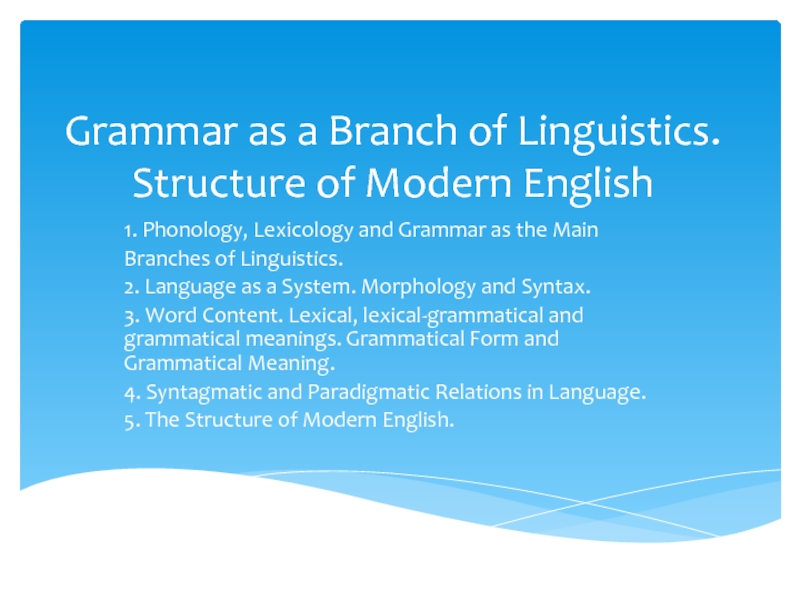
Слайд 2Intonation contours
Accents
Pauses
Patterns of word-order
Supra-segmental units
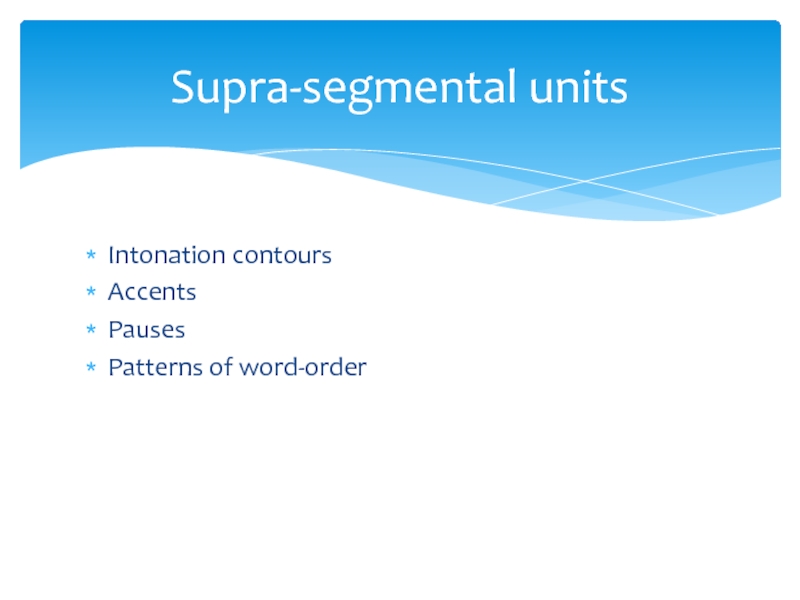
Слайд 3Super-sentential constructions (supra-proposemic level)
Sentences (proposemic level)
Denotemes (denotemic level)
Phrases (phrasemic level)
Lexemes (lexemic
level)
Morphemes (morphemic level)
Phonemes (phonemic level)
Segmental Units
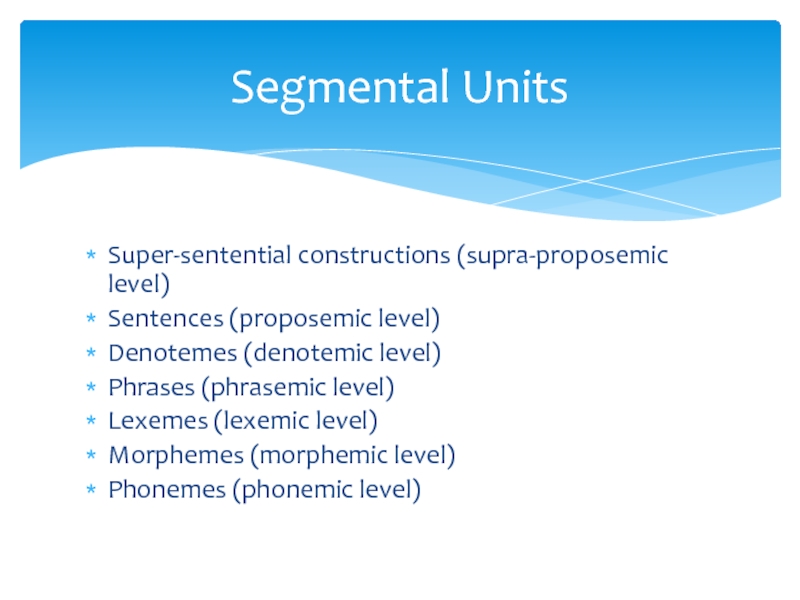
Слайд 5is the sum total of all the formal means constantly employed
to render this or that grammatical meaning
homogeneous grammemes build up a grammatical category
Grammmeme (K. Pike,
A.V. Bondarko)
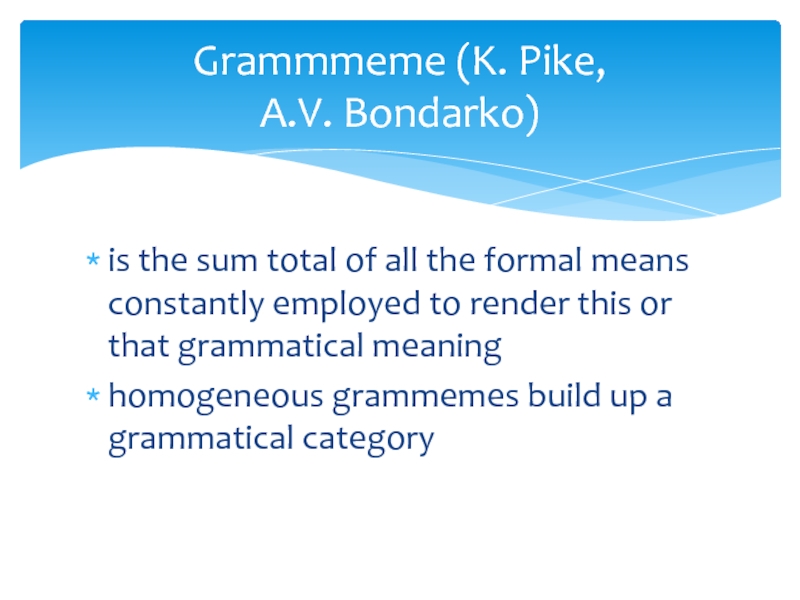
Слайд 6Never characterizes word as a whole
One form can render meanings of
different grammatical categories
One form cannot combine two meanings of the same grammatical category
Cannot be isolated, always a part of a grammatical category
Grammatical Form. Characteristics (A.I. Smirnitsky)
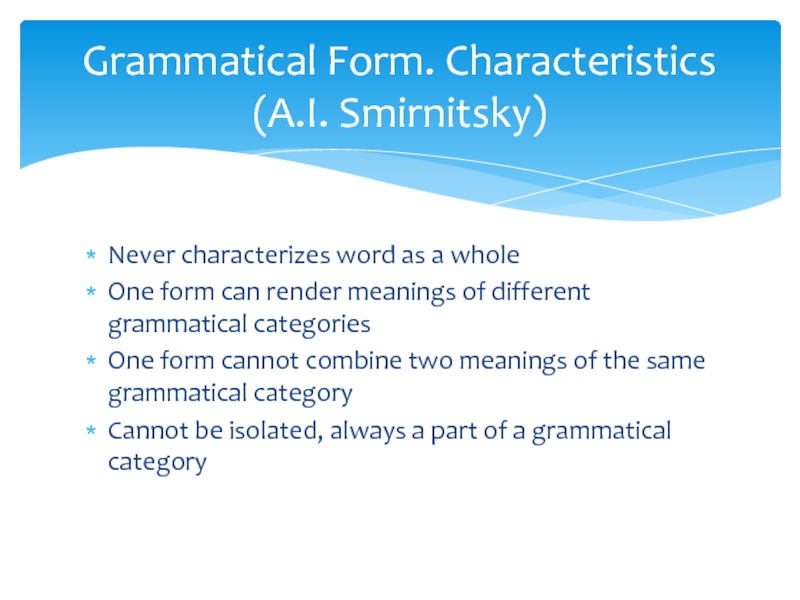
Слайд 7Synthetic forms:
Affixation
prefixation
infixation
suffixation
2. Sound interchange
Types of grammatical Forms
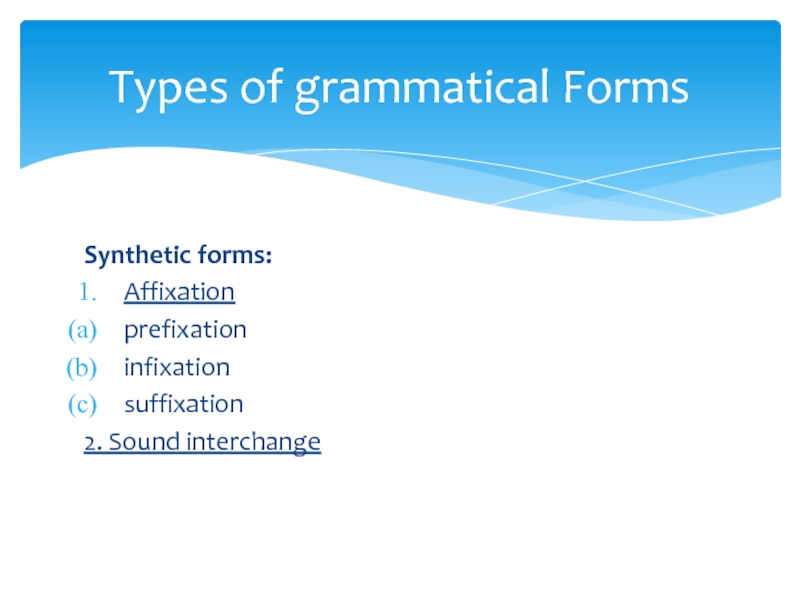
Слайд 8Analytical forms
a unity of a notional word and an auxiliary
word
Suppletive forms (A.I. Smirnitsky)
fully coincide in their lexical meaning
have no synonymous non-suppletive forms
other words of the same category have non-suppletive forms to express the same grammatical meaning
Types of Grammatical Forms
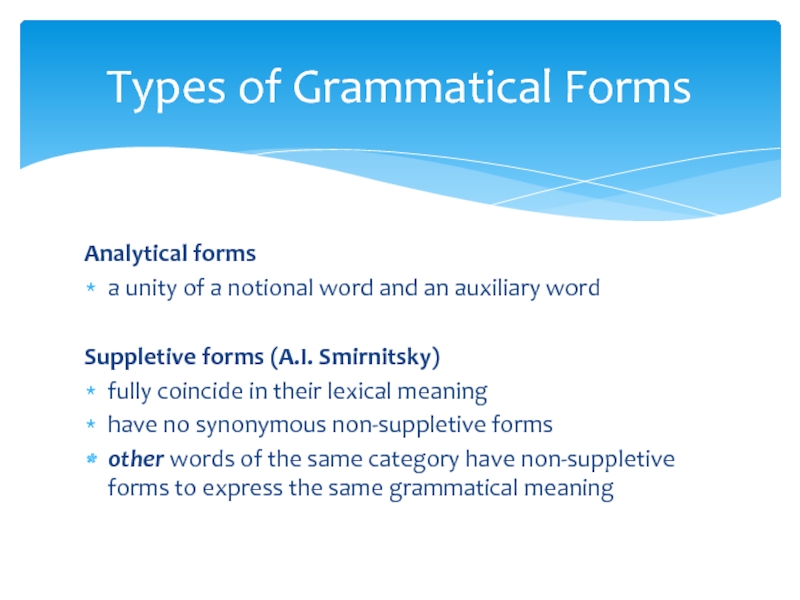
Слайд 10Analytical Language:
comparatively few grammatical inflections
sparing use of sound alternations to denote
grammatical forms
wide use of prepositions to denote relations and connect words
prominent use of word-order to denote grammatical relations; fixed word order
Modern English Structure
